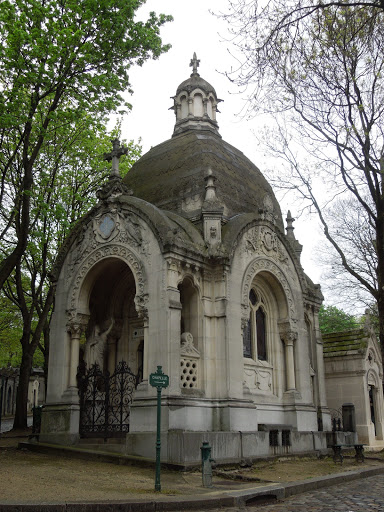The largest cemetery in Paris is Père Lachaise, which opened in 1804 and imported some of its first residents, such as Molière, from other graveyards as a promotional ploy to make the fairly remote site more attractive to potential tenants. This tactic evidently paid off because today there is a long waiting list for admission and plots are rented out in 30-year leases. Here's a closer look.

Cimetière du Père Lachaise.

The grave of Jean-Baptiste Poquelin, better known as Molière, French comedic playwright known for Tartuffe and The Misanthrope.




Édith Piaf, the "Little Sparrow," was a beloved French chanteuse famous for songs like "La Vie en rose" and "Non, je ne regrette rien." Her last words were "Every damn fool thing you do in this life, you pay for."



James Douglas Morrison, dionysian lead singer of The Doors who died mysteriously in a bathtub in Paris. Conspiracists believe his death was faked and he still walks among us.

A bust of Morrison once topped the grave but it was stolen.


The grave of Irish poet, playwright, and perennially-quoted wit Oscar Wilde, who died in a Paris hotel in 1900. His alleged last words were "My wallpaper and I are fighting a duel to the death. One of us has got to go." The Picture of Dorian Gray, The Importance of Being Earnest, and The Ballad of Reading Gaol are a few of his notable works.

The most popular attraction in the place, Wilde's grave was surrounded by a cluster of youths when I first approached. "Who's this guy again?" one of them asked his pal.


The monument is currently barricaded to prevent exuberant visitors from kissing the surface of the sculpture, which has become a tradition of sorts. Presumably cemetery management was concerned about erosion.

Marcel Proust, best known for the seven-volume magnum opus, À la recherche du temps perdu. See my earlier entry Literary Paris for a museum exhibit of his cork-lined bedroom.



Honoré de Balzac, novelist and playwright, proponent of Realism. Known for his Human Comedy collection.



Georges Méliès, illusionist and film pioneer. Everyone has seen clips from his movie Le Voyage dans la lune whether they realize it or not, specifically the shot of a rocket poking a custard pie-faced moon in the eye. During World War I the bulk of his original prints were melted down to make boots for French soldiers. Only a handful survived. Méliès' life was recently exhumed for the Martin Scorsese Oscar-winner Hugo.



Through the gates and back to the world of the living.
18 May 2012
Cemeteries of Paris (part 2)
Subscribe to:
Post Comments (Atom)
No comments:
Post a Comment